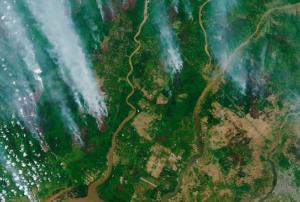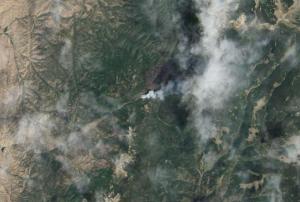Forest Fire
Definition
Facts and figures
Further information
UN-SPIDER Regional Support Offices with hazard-specific expertise
Related content on the Knowledge Portal
World Congress on Disaster Management (WCDM) is a unique initiative of DMICS to bring researchers, policy makers and practitioners from around the world in the same platform to discuss various challenging issues of disaster risk management. The mission of WCDM is to promote interaction of science, policy and practices to enhance understanding of risks and advance actions for reducing risks and building resilience to disasters.
The Conference will discuss various topics, including:
read more- Remote Sensing, GIS and Drones for Disaster Risk Management
- Early Warning of Hydro-Meteorological Disasters: Tasks Ahead
- Early Warning of Earthquakes: How Far, How Near
- Operationalising Early Warning of Landslides
- Application of Artificial Intelligence for Managing Risks of Disasters
- Emerging Technologies for Climate & Disaster Resistant Agriculture
The Conference will provide in-depth analysis of the…- read more
The head of the UN-SPIDER Bonn office and a visiting scientist from the Universidad Católica de Manizales conducted a webinar entitled “Introduction to Satellite Products and Services for the Management of Forest Fires” on 10 June. The aim of this webinar was to facilitate the use of space-based information for disaster management and emergency response, in particular to monitor and forecast forest fires.
The event took place on Wednesday, 10 June, at 5pm CEST (time for other time zones indicated in the image below) and was conducted in Spanish.
The recording of the webinar is available online.
The webinar discussed the following topics:
Introduction to UN-SPIDER and UNOOSA
…
08/06/2020 At the end of April and the beginning of May 2020, Peten, the northern province or department of Guatemala, experienced severe forest fires that forced Guatemala’s National Coordinating Agency for Disaster Reduction (CONRED) to request the activation of the International Charter Space and Major Disasters to map the geographical extent of the fires.
To support members of Guatemala’s technical, inter-institutional, GIS and remote sensing team for disaster management (GT-SIGER) in addressing the fires and their impact, Dr. Alexander Ariza, a visiting scientist with the UN-SPIDER programme, conducted a webinar on 7 May 2020 to highlight online products and resources that are available to map the burn severity of forest fires.
Forest fires have a major influence on ecosystems…
read more08/06/2020The head of the UN-SPIDER Bonn office and a visiting scientist from the Universidad Católica de Manizales will conduct a webinar entitled “Introduction to Satellite Products and Services for the Management of Forest Fires” (in Spanish). The aim of this webinar is to facilitate the use of space-based information for disaster management and emergency response, in particular to monitor and forecast forest fires.
The recording of the webinar is available online.
The webinar will discuss the following topics:
Introduction to UN-SPIDER and UNOOSA
Introduction to satellite atmospheric observations of fire emissions
State-of-the-art Copernicus operational data sets for monitoring smoke and fire emissions to the atmosphere
Copernicus Forest Fire Hazard and ECMWF data offering
Fire-related applications using LSA-SAF…
EO4GEO aims to bridge the skills gap between the supply and demand of education and training in the space/geospatial sectors, fostering the uptake and integration of space/geospatial data and services in a broad range of application domains.
The event includes sessions on:
- Introduction to Copernicus and Services (with COVID-19 examples)
- The role of Earth Observation in emergency situations
- NO2 Air pollution monitoring
- Three case studies on how satellite data combined with other data is valued for agriculture, nature conservation and monitoring of forest for detection of fire and diseases
- The role of EO in emergency situations
- Maritime Spatial Planning.
The training date is in the past. However, most of the training's content can be accessed here.
This is an online event through interactive data discovery and user practices on state-of-the-art operational datasets for detection of fire, related emissions and impacts
Here is an overview of the program:
- AC-SAF and S5P products
- Intro to data handling tools
- CAMS and GFAS
- EFFIS service
- LAND-SAF
- Sentinel 3 Copernicus Near Real Time (NRT) fire product
Esta capacitación avanzada cubrirá los siguientes temas 1) análisis del cambio en los bosques con datos SAR multi-temporales utilizando Google Earth Engine (GEE); 2) la clasificación de la cobertura terrestre con datos SAR y ópticos utilizando GEE; 3) el mapeo de manglares con SAR; 4) y la estimación de la altura de los bosques utilizando SAR. Cada sesión incluirá una porción teórica describiendo el uso de SAR para el mapeo de la cobertura relevante el enfoque de la sesión, seguida por una demostración de cómo acceder, descargar y analizar datos SAR para el mapeo y monitoreo del bosque. Estas demostraciones utilizan datos y software de libre acceso y de fuente abierta.
Objetivos de Aprendizaje:
- Para la conclusión de esta capacitación, los participantes podrán:
- Interpretar datos radar para el mapeo de los bosques
- Entender cómo se puede aplicar datos radar para el mapeo de la cobertura terrestre
- Estar familiarizados con…
A series of wildfires have been destroying forests and agricultural land near the abandoned Chernobyl nuclear power plant in Ukraine. Due to concerns about the spread of these fires and the potential dispersion of smoke plumes and radioactive chemicals to nearby inhabited areas, the European Union’s Emergency Response Coordinating Centre (ERCC) requested the activation of the Copernicus Emergency Management Service (EMS). Under the Copernicus EMS activation, satellites have mapped the actively burning fires, tracked the transport of smoke from fires, and assessed the damaged areas. These maps provide useful information for fire management and help authorities respond to the consequences of the wildfire.
Based on data from the Copernicus Sentinel-2 mission, using a wide-swath multispectral sensor that can…
read more21/04/2020Se revisan los métodos empleados para generar productos de área quemada mediante satélites de teledetección, analizando sus ventajas, así como los problemas actuales para obtener información confiable y consistente. Se comenta también cómo la información de área quemada puede combinarse con otras bases de datos espaciales para generar ciencia sobre causas e impactos de las quemas de biomasa.
RedLaTIF - http://www.redlatif.org
read more
La Red Latinoamericana de Teledetección e Incendios Forestales (RedLaTIF) es una red regional que pretende unir esfuerzos en el campo de la observación y gestión de los incendios forestales en todos los países latinoamericanos. Esta red está estrechamente unida al programa Global Observations of Forest and Land Cover Dynamics (GOFC/GOLD), la cual intenta contribuir en el cumplimiento de los objetivos de dicho programa.



